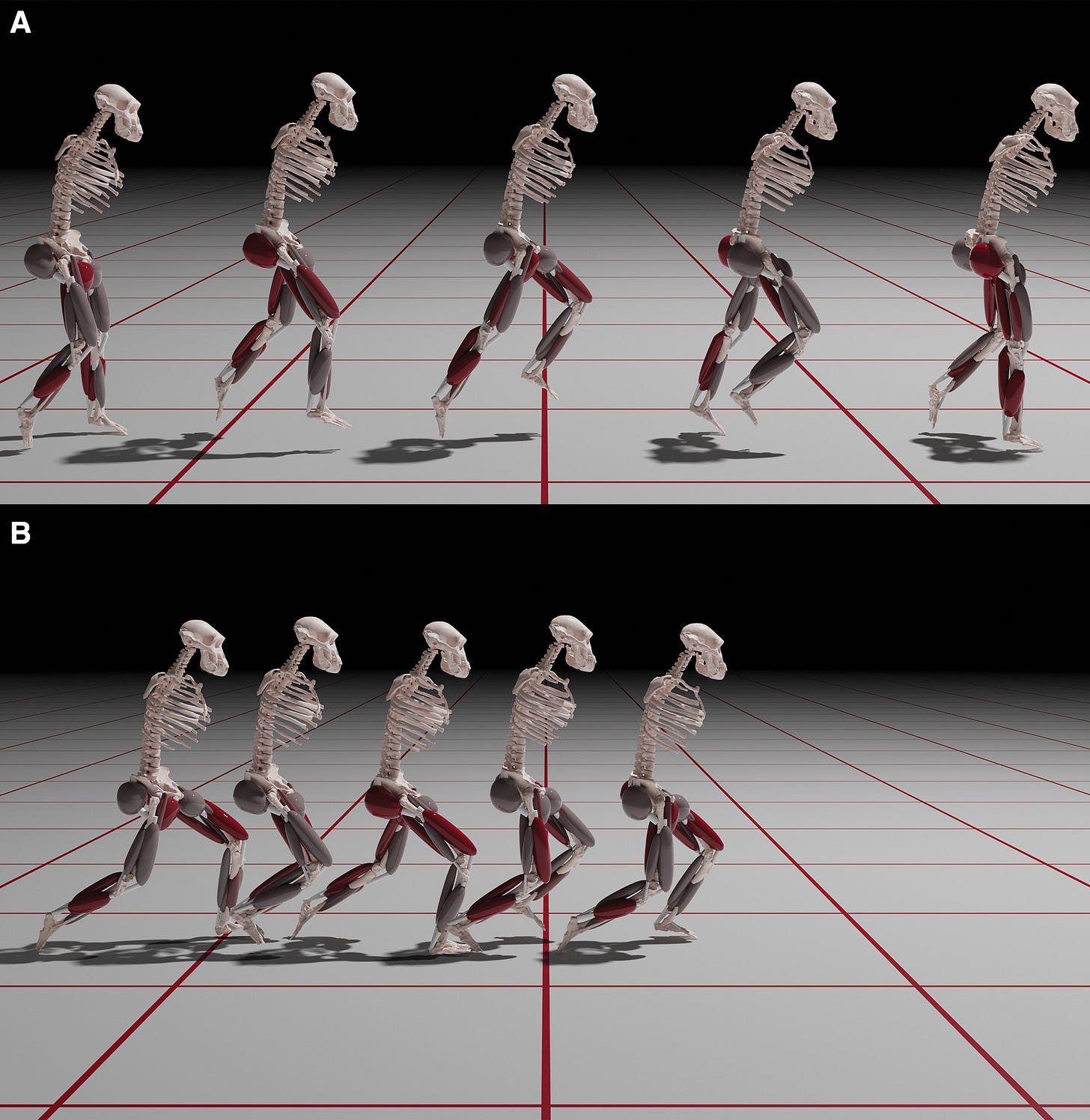
For decades, Australopithecus afarensis has been at the heart of debates surrounding the origins of human bipedalism. Fossilized footprints from Laetoli and skeletal remains like Lucy’s have provided compelling evidence that our ancestors walked upright as early as 3.7 million years ago. But walking is one thing—what about running?
A new study led by Karl Bates and published in Current Biology takes a fresh look at this question using state-of-the-art physics simulations. The researchers built a digital reconstruction of Lucy’s musculoskeletal system to estimate her maximum running speed and endurance capacity. Their findings suggest that, while A. afarensis could technically run, it was far from an efficient sprinter. Compared to modern humans, Lucy’s top speed was significantly lower, and her ability to sustain a running pace for long distances was extremely limited.
“Australopithecus was mechanically capable of bipedal running, but with absolute and relative maximum speeds considerably inferior to modern humans,” the authors explain.
One of the most important factors in running efficiency is the Achilles tendon. In modern humans, this spring-like structure stores and releases energy with each stride, reducing the effort required for running. But in A. afarensis, the Achilles tendon was much shorter, and the calf muscles were structured more like those of modern apes. The researchers’ simulations showed that this anatomical limitation resulted in slower running speeds and much higher energy costs compared to humans.
“The greater cost of transport in Australopithecus compared to modern humans can be largely explained by differences in body size and Achilles tendon architecture,” the study notes.
By modifying their digital model, the researchers tested how different anatomical traits affected running performance. When they altered Lucy’s musculature to resemble a modern human, her speed improved—but still fell far short of even an average non-athletic human today.
So, what was Lucy’s top speed? The study estimates that A. afarensis had a maximum running velocity between 1.7 and 4.97 meters per second, or about 3.8 to 11 mph. To put that in perspective, an average untrained human can reach 12 to 15 mph in a sprint, while elite sprinters like Usain Bolt exceed 27 mph.
“After size-normalization to remove the effects of body size, running speed remained considerably lower in Australopithecus compared to our human model,” the researchers write.
Not only was A. afarensis slower, but it had a very limited range of speeds it could sustain over time. Unlike humans, who can vary their pace for endurance running, Lucy was constrained to a narrow speed range, making long-distance pursuits unlikely.
The ability to run efficiently is one of the defining characteristics of Homo erectus, which emerged around 1.9 million years ago. Unlike A. afarensis, H. erectus had long legs, a well-developed Achilles tendon, and a spring-like foot arch—all features that made it a capable endurance runner. Some researchers believe these traits were crucial for persistence hunting, a strategy where early humans chased prey to exhaustion.
Lucy, by contrast, likely relied more on walking and climbing rather than pursuit hunting. Her short legs and energy-intensive running style suggest she was not built for long chases across the savanna. Instead, she may have used ambush tactics, scavenging, or tree-based foraging to acquire food.
“Our results support the hypothesis that key features in the human body plan evolved specifically for improved running performance and not merely as a byproduct of selection for enhanced walking capabilities,” the study concludes.
This research provides a clearer picture of where A. afarensis fits into the story of human locomotion. While Lucy and her relatives were already committed bipeds, they lacked the anatomical refinements that later allowed humans to become endurance athletes.
The study also underscores the power of computational modeling in paleoanthropology. By digitally reconstructing ancient skeletons, researchers can test biomechanical hypotheses that would be impossible to evaluate otherwise. This approach will likely be used to investigate other early hominin species, providing further insight into the evolution of human movement.
“By systematically manipulating the anatomy of Australopithecus in our simulations, we were able to isolate the impact of key traits on running performance,” the researchers write.
As new fossil discoveries and technological advancements refine our understanding, one thing is clear: the path to becoming human was not a sprint—it was a slow, evolutionary marathon.
-
“The Running Man Hypothesis: How Endurance Running Shaped Human Evolution”
Examines the persistence hunting theory and its role in early Homo evolution.
Read more -
“Australopithecus in Motion: Reconstructing Early Hominin Locomotion”
Uses biomechanical modeling to explore walking and climbing in early hominins.
Read more -
“From Lucy to Us: The Evolution of Bipedalism and Running”
Investigates key anatomical changes that led to human-like running abilities.
Read more








